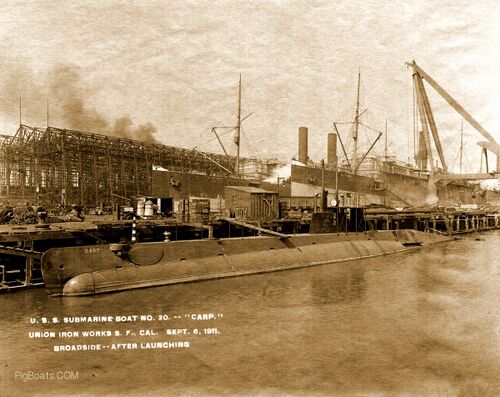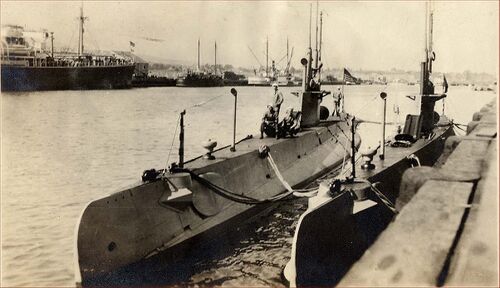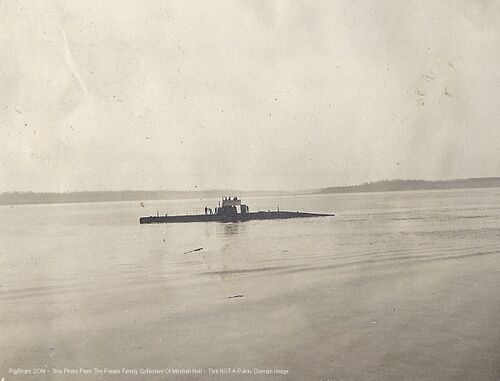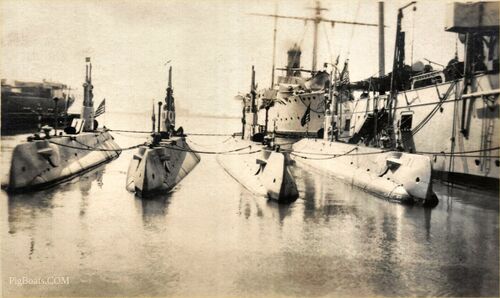F-class: Difference between revisions
Pbcjohnston (talk | contribs) |
Pbcjohnston (talk | contribs) mNo edit summary |
||
| (7 intermediate revisions by the same user not shown) | |||
| Line 1: | Line 1: | ||
[[File:F- | {{#seo:|title=F-class submarines US Navy - PigBoats.COM|title_mode=replace|keywords=US Navy F-class subs, F-class submarine design, early American submarines, pre-WWI submarines}} | ||
{{#seo:|description=Notes, photographs, and pictures of the U.S. Navy's F-class submarines.}} | |||
[[File:New Header F-class.jpg]] | |||
=== <big>Design, Construction, and Naming Notes</big> === | === <big>Design, Construction, and Naming Notes</big> === | ||
<div style="text-align: justify;"><span style="color:#00008B">The F-class were harbor defense submarines designed by the Electric Boat Company (EB) of New York City (later Groton, CT.). Essentially enlarged E-class boats, they were built by two different yards: F-1 and F-2 were constructed at Union Iron Works of San Francisco. F-3 and F-4 were built at The Moran Company of Seattle, the first submarines built in the Pacific Northwest. These boats were originally named Carp, Barracuda, Pickerel, and Skate (in order). On November 17, 1911, while still under construction, the Navy changed its naming convention for submarines and these boats received their F-class names. They were commissioned with the F names in mid 1912 and early 1913. F-2 and F-3 survived long enough to have their original general submarine series designation changed to the SS series on July 17, 1920. F-1 and F-4 had been lost in accidents by that time and were not officially redesignated. | <div style="text-align: justify;"><span style="color:#00008B">The F-class were harbor defense submarines designed by the Electric Boat Company (EB) of New York City (later Groton, CT.). Essentially enlarged E-class boats, they were built by two different yards: F-1 and F-2 were constructed at Union Iron Works of San Francisco. F-3 and F-4 were built at The Moran Company of Seattle, the first submarines built in the Pacific Northwest. These boats were originally named Carp, Barracuda, Pickerel, and Skate (in order). On November 17, 1911, while still under construction, the Navy changed its naming convention for submarines and these boats received their F-class names. They were commissioned with the F names in mid 1912 and early 1913. F-2 and F-3 survived long enough to have their original general submarine series designation changed to the SS series on July 17, 1920. F-1 and F-4 had been lost in accidents by that time and were not officially redesignated. | ||
These four boats were the first submarines to operate out of Hawaii. They were based at Piers 5 and 5A in Honolulu, as the facilities in Pearl Harbor were still in a nascent stage and under construction. Although generally well regarded, by November 1915 they were badly in need of a full Navy yard overhaul and Pearl was still not ready for them. In the aftermath of the F-4 disaster they were towed back to Mare Island Navy Yard and after several months of lying in partial commission ([https://en.wikipedia.org/wiki/In_ordinary '''in ordinary'''] status) they were overhauled and put back into full service, with F-2 and F-3 serving well until 1922. F-1 was lost in a [https://pigboats.com/index.php?title=Notable_Submarine_Accidents#F-1_(Submarine_No._20),_Collision_with_F-3_(Submarine_No._22),_December_17,_1917 '''collision with F-3 while on maneuvers off San Diego in 1917.'''] | |||
[[File:Red bar sub.jpg]] | [[File:Red bar sub.jpg]] | ||
=== <big>F-1 (Submarine No. 20)</big> === | <div style="text-align: justify;"><span style="color:#000000"> | ||
=== <big>Carp/F-1 (Submarine No. 20)</big> === | |||
[[File:F-1 Carp-Union Iron 1911.jpg|left|500px|Photo contributed by Darryl Baker from the files of the Vallejo Naval & Historical Museum.]] | [[File:F-1 Carp-Union Iron 1911.jpg|left|500px|Photo contributed by Darryl Baker from the files of the Vallejo Naval & Historical Museum.]] | ||
<div style="text-align: justify;"><span style="color:#00008B">The yet to be commissioned submarine Carp seen dockside at the Union Iron Works Shipyard in San Francisco. It will be renamed F-1 just two months after this photo was taken. The vertical "21" on her conning tower fairwater IS NOT her hull number. These vertical numbers were to denote the boat's place in a squadron at-sea steaming formation. This was a common practice of the day, and unfortunately the ease at which these numbers could be mistaken for the hull number was apparently lost on the Navy. The two large ocean liners in the background are the SS Ventura and the SS Sonoma, both of which plied the U.S. to Australia passenger trade.</span> | <div style="text-align: justify;"><span style="color:#00008B">The yet to be commissioned submarine Carp seen dockside at the Union Iron Works Shipyard in San Francisco. It will be renamed F-1 just two months after this photo was taken. The vertical "21" on her conning tower fairwater IS NOT her hull number. These vertical numbers were to denote the boat's place in a squadron at-sea steaming formation. This was a common practice of the day, and unfortunately the ease at which these numbers could be mistaken for the hull number was apparently lost on the Navy. The two large ocean liners in the background are the SS Ventura and the SS Sonoma, both of which plied the U.S. to Australia passenger trade.</span> | ||
| Line 14: | Line 21: | ||
[[File:Red bar sub.jpg]] | [[File:Red bar sub.jpg]] | ||
=== <big>F-2 (Submarine No. 21, later SS-21)</big> === | <div style="text-align: justify;"><span style="color:#000000"> | ||
=== <big>Barracuda/F-2 (Submarine No. 21, later SS-21)</big> === | |||
[[File:On deck1.jpg|left|500px|Photo courtesy of Mike Dilley; whose father, Homer 'Pat' Dilley sailed aboard the USS F-2.]] | [[File:On deck1.jpg|left|500px|Photo courtesy of Mike Dilley; whose father, Homer 'Pat' Dilley sailed aboard the USS F-2.]] | ||
<div style="text-align: justify;"><span style="color:#00008B">F-2 moored alongside F-3, most likely in San Pedro (Los Angeles), CA., 1917-1918. The large round canister on deck above the bow planes was a fairing that covered portions of the bow planes operating mechanism. The Allied Signal Bell is very prominent on the forward deck.</span> | <div style="text-align: justify;"><span style="color:#00008B">F-2 moored alongside F-3, most likely in San Pedro (Los Angeles), CA., 1917-1918. The large round canister on deck above the bow planes was a fairing that covered portions of the bow planes operating mechanism. The Allied Signal Bell is very prominent on the forward deck.</span> | ||
| Line 22: | Line 31: | ||
[[File:Red bar sub.jpg]] | [[File:Red bar sub.jpg]] | ||
=== <big>F-3 (Submarine No. 22, later SS-22)</big> === | <div style="text-align: justify;"><span style="color:#000000"> | ||
=== <big>Pickerel/F-3 (Submarine No. 22, later SS-22)</big> === | |||
[[File:F-3 pt townsend bay-6.jpg|left|500px|Photo is from the Private Family Collection of Mitchell Noll ~ NOT a Public Domain Image.]] | [[File:F-3 pt townsend bay-6.jpg|left|500px|Photo is from the Private Family Collection of Mitchell Noll ~ NOT a Public Domain Image.]] | ||
<div style="text-align: justify;"><span style="color:#00008B">F-3 heading out on one of a series of builder's trials, spring 1912. She has just backed away from a Moran Shipbuilding dock in Port Townsend Bay north of Seattle, WA. In the background is the north end of Marrowstone Island to the left, and on the right is Indian Island across Port Townsend Bay. View is looking south.</span> | <div style="text-align: justify;"><span style="color:#00008B">F-3 heading out on one of a series of builder's trials, spring 1912. She has just backed away from a Moran Shipbuilding dock in Port Townsend Bay north of Seattle, WA. In the background is the north end of Marrowstone Island to the left, and on the right is Indian Island across Port Townsend Bay. View is looking south.</span> | ||
| Line 30: | Line 41: | ||
[[File:Red bar sub.jpg]] | [[File:Red bar sub.jpg]] | ||
=== <big>F-4 (Submarine No. 23)</big> === | <div style="text-align: justify;"><span style="color:#000000"> | ||
=== <big>Skate/F-4 (Submarine No. 23)</big> === | |||
[[File:F4.jpg|left|500px|USN photo # NH 74736, courtesy of the Naval History & Heritage Command]] | [[File:F4.jpg|left|500px|USN photo # NH 74736, courtesy of the Naval History & Heritage Command]] | ||
<div style="text-align: justify;"><span style="color:#00008B">F-4 photographed alongside in Honolulu, T.H., fall of 1914. At this time the big base in Pearl Harbor was still under construction and was not able to host ships. The F-class submarines were docked at a pier at the end of Richards St. in Honolulu. Just a few months after this photo was taken, F-4 and her crew [[Notable Submarine Accidents|'''would be lost in a tragic accident''']].</span> | <div style="text-align: justify;"><span style="color:#00008B">F-4 photographed alongside in Honolulu, T.H., fall of 1914. At this time the big base in Pearl Harbor was still under construction and was not able to host ships. The F-class submarines were docked at a pier at the end of Richards St. in Honolulu. Just a few months after this photo was taken, F-4 and her crew [[Notable Submarine Accidents|'''would be lost in a tragic accident''']].</span> | ||
| Line 37: | Line 50: | ||
[[File:Red bar sub.jpg]] | [[File:Red bar sub.jpg]] | ||
<div style="text-align: justify;"><span style="color:#000000"> | |||
=== <big>General F-class Photos</big> === | === <big>General F-class Photos</big> === | ||
[[File:All 4 F Honolulu.jpg|left|500px|Photo in the private collection of Ric Hedman]] | [[File:All 4 F Honolulu.jpg|left|500px|Photo in the private collection of Ric Hedman]] | ||
<div style="text-align: justify;"><span style="color:#00008B">This really nice portrait of the four F-class submarines was taken in Honolulu Harbor circa early 1915, between the Navy Docks 5 and 5A. Left to right, F-2, F-3, F-4, & F-1. The boats are moored to the submarine tender USS Alert (Submarine Tender No. 4). | <div style="text-align: justify;"><span style="color:#00008B">This really nice portrait of the four F-class submarines was taken in Honolulu Harbor circa early 1915, between the Navy Docks 5 and 5A. Left to right, F-2, F-3, F-4, & F-1. The boats are moored to the submarine tender [https://www.navsource.org/archives/09/36/3604.htm '''USS Alert (Submarine Tender No. 4)''']. | ||
Though the names on the hull are indistinct, on a few submarines the shape of the bow planes pivot covers help separate the vessels into where each was built. The two outer submarines have covers with sloping top and bottoms and were built at Union Iron Works in San Francisco. (F1 and F-2). The two middle submarines have covers with flat tops and bottoms and were built at the Moran Company in Seattle, Washington. (F-3 and F-4) These features remained the same through their whole careers. | Though the names on the hull are indistinct, on a few submarines the shape of the bow planes pivot covers help separate the vessels into where each was built. The two outer submarines have covers with sloping top and bottoms and were built at Union Iron Works in San Francisco. (F1 and F-2). The two middle submarines have covers with flat tops and bottoms and were built at the Moran Company in Seattle, Washington. (F-3 and F-4) These features remained the same through their whole careers. | ||
Though this is a really great image of the four F-class submarines, the real interesting story is taking place just behind them. The vessel seen astern of the Alert is the German unprotected cruiser SMS Geier, as seen in other photos. After the U.S. entered WW I the Geier was seized by the U.S. and pressed into service as the USS Schurz. She later sank in a ramming on the U.S. east coast. | Though this is a really great image of the four F-class submarines, the real interesting story is taking place just behind them. The vessel seen astern of the Alert is the German unprotected cruiser SMS Geier, as seen in other photos. After the U.S. entered WW I the Geier was seized by the U.S. and pressed into service as the [https://www.navsource.org/archives/12/09921.htm '''USS Schurz''']. She later sank in a ramming on the U.S. east coast. | ||
The vessel on the left is thought to be the German steamship Locksun (ex-German SS Andree Rickmers), that had been pressed into service as a collier for the Geier. She took refuge a day or so later than the Geier from the Japanese | The vessel on the left is thought to be the German steamship Locksun (ex-German SS Andree Rickmers), that had been pressed into service as a collier for the Geier. She took refuge a day or so later than the Geier from the Japanese battleship [https://en.wikipedia.org/wiki/Russian_battleship_Retvizan '''Hizen'''], who was attempting to locate the German ships in Hawaiian waters. Locksun was not an interned ship at first because her connection with Geier was not known at the time. Locksun even took prisoners from the sunken German power schooner Aeolus from Hizen and brought them aboard the Locksun. Once her connection was known she was interned as well. After the U.S. entered the war she was renamed the [https://www.navsource.org/archives/09/13/130005.htm '''USS Gulfport (AK-5)'''] and remained in U.S. service until 1922. | ||
It is interesting to note that as soon as the U.S. entered WW I all interned ships in U.S. ports around the world tried to destroy their engines and/or scuttle the ships in harbors to block them. Geier set fire to her engine room and boilers. Locksun damaged her engines. | |||
Directly behind the F-3, (second from left) can be seen the [[Harbor Light|'''Honolulu Harbor Light Station''']] lighthouse on Sand Island. On the deck of the F-3 there is a crewman lounging with his back leaning against the conning tower fairwater in the shade.</span> | Directly behind the F-3, (second from left) can be seen the [[Harbor Light|'''Honolulu Harbor Light Station''']] lighthouse on Sand Island. On the deck of the F-3 there is a crewman lounging with his back leaning against the conning tower fairwater in the shade.</span> | ||
Latest revision as of 15:07, 8 May 2025
Design, Construction, and Naming Notes
These four boats were the first submarines to operate out of Hawaii. They were based at Piers 5 and 5A in Honolulu, as the facilities in Pearl Harbor were still in a nascent stage and under construction. Although generally well regarded, by November 1915 they were badly in need of a full Navy yard overhaul and Pearl was still not ready for them. In the aftermath of the F-4 disaster they were towed back to Mare Island Navy Yard and after several months of lying in partial commission (in ordinary status) they were overhauled and put back into full service, with F-2 and F-3 serving well until 1922. F-1 was lost in a collision with F-3 while on maneuvers off San Diego in 1917.
Carp/F-1 (Submarine No. 20)

Barracuda/F-2 (Submarine No. 21, later SS-21)

Pickerel/F-3 (Submarine No. 22, later SS-22)

Skate/F-4 (Submarine No. 23)

General F-class Photos

Though the names on the hull are indistinct, on a few submarines the shape of the bow planes pivot covers help separate the vessels into where each was built. The two outer submarines have covers with sloping top and bottoms and were built at Union Iron Works in San Francisco. (F1 and F-2). The two middle submarines have covers with flat tops and bottoms and were built at the Moran Company in Seattle, Washington. (F-3 and F-4) These features remained the same through their whole careers.
Though this is a really great image of the four F-class submarines, the real interesting story is taking place just behind them. The vessel seen astern of the Alert is the German unprotected cruiser SMS Geier, as seen in other photos. After the U.S. entered WW I the Geier was seized by the U.S. and pressed into service as the USS Schurz. She later sank in a ramming on the U.S. east coast.
The vessel on the left is thought to be the German steamship Locksun (ex-German SS Andree Rickmers), that had been pressed into service as a collier for the Geier. She took refuge a day or so later than the Geier from the Japanese battleship Hizen, who was attempting to locate the German ships in Hawaiian waters. Locksun was not an interned ship at first because her connection with Geier was not known at the time. Locksun even took prisoners from the sunken German power schooner Aeolus from Hizen and brought them aboard the Locksun. Once her connection was known she was interned as well. After the U.S. entered the war she was renamed the USS Gulfport (AK-5) and remained in U.S. service until 1922.
It is interesting to note that as soon as the U.S. entered WW I all interned ships in U.S. ports around the world tried to destroy their engines and/or scuttle the ships in harbors to block them. Geier set fire to her engine room and boilers. Locksun damaged her engines.
Directly behind the F-3, (second from left) can be seen the Honolulu Harbor Light Station lighthouse on Sand Island. On the deck of the F-3 there is a crewman lounging with his back leaning against the conning tower fairwater in the shade.
See more General F-class photos
Page created by:
Ric Hedman & David Johnston
1999 - 2023 - PigBoats.COM©
Mountlake Terrace, WA, Norfolk, VA
webmaster at pigboats dot com
